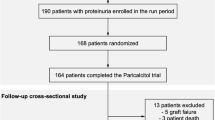Abstract
Accurate assessment of proteinuria in pediatric patients infected with the human immunodeficiency virus (HIV) is limited by constraints imposed by timed urine collections and low creatinine excretion in very ill patients with low muscle mass. We therefore sought to validate the use of random urine specimens to quantitate total protein and creatinine excretion in a population of 236 HIV-positive children. A mathematical derivation for estimating urine volume (V) was constructed. The accuracy of the final calculation [V=832 (kL/ucr)BSA] (where k=constant, L body length, UCr urine creatinine and BSA body surface area) was tested by regression analysis comparing the calculated and measured volume of 31 urines from ambulatory HIV-negative patients. The correlation coefficient was highly significant (r=0.77. P≤0.0001). The relationship was also applied to 23 times urine specimens from HIV-positive patients with similar significance (r=0.87k, P<0.0001). A regression analysis of measured proteinuria against the urine protein: creatinine ratio (Upr/UCr) in these same urines from the HIV-positive patients yielded a significant relationship both in the linear (r=0.95, y=0.4x) and the logarithmic regression (r=0.97, y=x+0.4). These data support the use of random Upr/UCr ratios to estimate daily proteinuria in HIV-infected pediatric patients despite low creatinine excretion rates. The previously accepted values continue to apply, with Upr/UCr ≤2.0 considered normal and >2.0 representative of nephrotic proteinuria.
Similar content being viewed by others
References
Abitbol C, Zileruelo G, Freundlich M, Strauss J (1990) Quantitation of proteinuria with urinary protein/creatinine ratios and random testing with dipsticks in nephroitic children. J Pediatr 116:243–247.
Ginsberg JM, Chang BS, Matares RA, Garella S (1983) Use of single voided urine samples to estimate quantitative proteinuria. N Engl J Med 309:1543–1546.
Houser M (1984) Assessment of proteinuria using random urine samples. J Pediatr 104:845–848.
Schwab SJ, Christensen RL, Dougherty K, Klahr S (1987) Quantitation of proteinuria by use of the protein-to-creatinine ratios in single urine samples. Arch Intern Med 147:943–944.
Schwartz GJ, Haycock GB, Edelmann CM, Spitzer A (1976) A simple estimate of glomerular filtration rate in children derived from body length and plasma creatinine. Pediatrics 58:259–263.
Schwartz GJ, Feld L, Langford D (1984) A simple estimate of glomerular filtration rate in full-term infants during the first year of life. J Pediatr 104:849–854.
Dubois D and Dubois EF (1916) Nomograms of body surface area in adults and children from height and weight measurements. Arch Intern Med 17:863–871.
Brion L, Boeck M, Gauthier B, Nussbaum M, Schwartz G (1989) Estimation of glomerular filtration rate in anorectic adolescents. Pediatr Nephrol 3:16–21.
Hammer LD, Kraemer HC, Wilson DM, Ritter PL, Dornbusch SM (1991) Standardized percentile curves of body mass index for children and adolescents. Am J Dis Child 145:259–263.
Heymsfield S, Arteaga C, McMannus C, Smith J, Moffitt S (1983) Measurement of muscle mass in humans: validity of the 24 hours urinary creatinine method. Am J Clin Nutr 37:478–494.
McIntosh JC (1977) Application of dye-binding method to the determination of protein in urine and cerebrospinal fluid. Clin Chem 23:1939–1940.
Slot C: Plasma creatinine determination (1965) a new and specific Jaffe reaction method. Scand J Clin Lab Invest 17:381-387.
Mathews DE, Farewell VT (1988) Using and understanding medical statistics, 2nd edn. Karger, New York, pp. 1–19 and 124–140.
Bland JM, and Altman DG (1986) Statistical methods for assessing agreement between two methods of clinical measurement. Lancet I: 307–310.
Haycock G (1989) Creatinine, body size, and renal function. Pediatr Nephrol 3:22–24.
Schwartz G (1992) Does kL/Pcr estimate GFR, or dose GFR determine k? Pediatr Nephrol 6:512–515.
Author information
Authors and Affiliations
Rights and permissions
About this article
Cite this article
Abitbol, C.L., Strauss, J., Zilleruelo, G. et al. Validity of random urines to quantitate proteinuria in children with human immunodeficiency virus nephropathy. Pediatr Nephrol 10, 598–601 (1996). https://doi.org/10.1007/s004670050169
Received:
Revised:
Accepted:
Issue Date:
DOI: https://doi.org/10.1007/s004670050169




